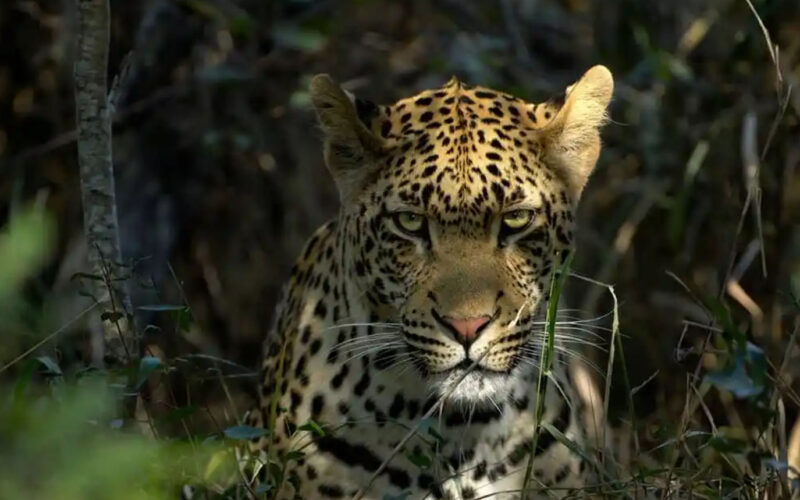Amidst the bustling urban landscape of Sainik Farms in Delhi, a spellbinding narrative unfolds as a mysterious visitor, in the form of a leopard, ventures into the heart of the city. This unexpected convergence of the untamed wilderness and metropolitan life challenges our understanding of the boundaries between civilization and the wild. Virender Singh, a diligent guard and daily commuter, becomes the storyteller of an encounter that not only incites disbelief among locals but also prompts a profound examination of the intricate relationship between urbanity and wildlife.
The leopard’s sudden appearance on December 2 triggers a cascade of reactions, from initial skepticism to a collective realization as videos surface and paw prints are discovered. Larger than a dog yet smaller than a nilgai, the enigmatic presence of the leopard defies conventional expectations, inviting a deeper contemplation of the coexistence between urban sprawl and the untamed wilderness.
While Delhi, a sprawling metropolis steeped in history and cultural diversity, may seem an improbable habitat for leopards, the roots of this compelling encounter stretch back to the Aravallis. This 670km-long mountain range, stretching from Gujarat to Delhi, harbors the Asola Bhatti Wildlife Sanctuary, a mere 2km north of Sainik Farms, emerging as a pivotal haven for these adaptable predators.
Environmental researcher Sunil Harsana casts light on the leopards’ exceptional adaptability, thriving in diverse environments ranging from dense tropical forests to rocky terrains like the Aravallis. The 2016 study, in which Harsana actively participated, meticulously documented 31 leopards across a 128km stretch of the Aravallis in Haryana. A comprehensive study in 2019-20 by the Centre for Ecology Development and Research (CEDAR) and WWF-India further highlighted the higher likelihood of encountering a leopard in the Mangar Bani stretch of the Aravallis compared to the Asola sanctuary.
The surge in leopard sightings is attributed to increased anthropogenic pressure, illegal construction, mining, and encroachments, compelling these magnificent creatures to navigate from the Haryana side of the Aravallis to the Delhi side. The Delhi Forest department’s year-long mammal census between 2021 and 2022 revealed at least eight leopards in the Asola Bhatti Wildlife Sanctuary, marking the highest recorded number.
Faiyaz Khudsar, the scientist-in-charge of Delhi Development Authority’s biodiversity parks program, underscores the pivotal role of habitat restoration in attracting leopards to Delhi. Diligent efforts to develop Asola Bhatti and Tilpath Valley as conducive habitats have not only benefited leopards but also various other species, encouraging them to explore territories closer to human settlements.
Vijay Dhasmana, an ecologist at the Aravalli Biodiversity Park in Gurugram, astutely observes the escalating encroachment on the Aravallis, leading to habitat loss and disturbance for the leopards. This encroachment has fueled migration, with leopards compelled to explore new territories to avoid escalating human interactions.
The juxtaposition of urban development and wildlife habitat becomes increasingly evident in Sainik Farms, a cooperative society developed for defense personnel and their families in 1961. The once sprawling farmland has undergone a metamorphosis, encroaching on adjacent forest areas, bringing residents face-to-face with the indigenous wildlife that calls the Aravallis home.
As the leopard continues its prowl, the residents have mobilized, collaborating with the Delhi Forest department to ensure safety. A quick-reaction team (QRT), comprising colony security guards, has been formed, implementing a comprehensive set of safety measures, including banners, enhanced lighting, and a fervent request for barbed wires around the Asola Bhatti sanctuary.
Drawing insightful parallels with Mumbai’s Sanjay Gandhi National Park (SGNP), where leopards coexist harmoniously with human populations, suggests a model of coexistence through awareness. Mumbai’s “Mumbaikars for SGNP” project focuses on educating residents about precautions during leopard encounters, avoiding solitary ventures at night, and refraining from provoking the animals.
While Delhi adapts to this unexpected wildlife encounter, profound questions arise about sustainable coexistence and the necessity for long-term conservation measures. The leopard’s return to Sainik Farms serves as a poignant reminder that, for these creatures, the Aravallis were home long before the cityscape took shape, urging a harmonious balance between urban development and the preservation of natural habitats.
This unprecedented intersection of the urban and the wild beckons a deeper exploration of our role as custodians of the environment and stewards of the delicate balance between civilization and nature. As we navigate the intricate web of urban wildlife, we find ourselves compelled to embark on a journey of greater understanding, cooperation, and sustainable coexistence.
